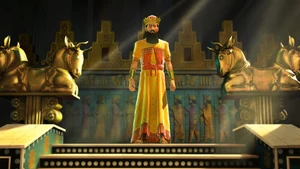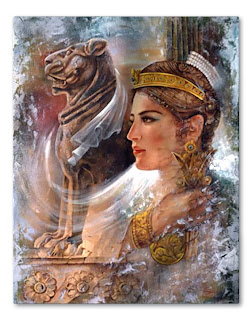by
Damien
F. Mackey
The Book of Daniel presents historians with difficulties regarding
both the Neo-Babylonian and the Medo-Persian successions. An unknown king
“Belshazzar”, given as the son
(and presumably successor) of “Nebuchednezzar”, is slain, and his
kingdom then passes into the hands of a likewise unknown monarch who is called
“Darius the Mede”.
King Belshazzar
The many ‘historical inaccuracies’ that critics
claim to find in the Book of Daniel are, as I have previously argued, not
faults of ignorance on the part of Daniel (or whichever author[s]), but the
limitations imposed upon historical knowledge by a one-dimensional conventional
history.
See e.g. my”
“Nebuchednezzar” of the Book of
Daniel
According to this revision, King Nabonidus, the
penultimate king of the Neo-Babylonian dynasty - who in so many ways fits the
description of the “Nebuchednezzar” of the Book of Daniel (as critics have
noted) - is an alter
ego of the mighty Chaldean king Nebuchednezzar II.
Already this new vision of history manages to
establish that:
there
was an historical king like Daniel’s “Nebuchednezzar”;
and
he, just like “Nebuchednezzar”, had a notable son named Belshazzar;
Now, given my equation, Nebuchednezzar =
Nabonidus, I was gratified to learn of documentary evidence attesting to some
apparent mad or erratic behaviour on the part of king Nebuchednezzar II, to
complement the well-attested “Madness of Nabonidus”.
I have also concluded - based on a strikingly
parallel situation - that Evil-Merodach, son and successor of Nebuchednezzar
II, was Belshazzar. I reproduce that information here (with ref. to British Museum tablet No. BM 34113 (sp 213), published by A. K.
Grayson in 1975):
Read lines 3,
6, 7, 11, 12, and Mas referring to strange behavior by Nebuchadnezzar, which
has been brought to the attention of Evilmerodach by state officials. Life had
lost all value to Nebuchadnezzar, who gave contradictory orders, refused to
accept the counsel of his courtiers, showed love neither to son nor daughter,
neglected his family, and no longer performed his duties as head of state with
regard to the Babylonian state religion and its principal temple. Line 5, then,
can refer to officials who, bewildered by the king's behavior, counseled
Evilmerodach to assume responsibility for affairs of state so long as his
father was unable to carry out his duties. Lines 6 and on would then be a
description of Nebuchadnezzar's behavior as described to Evilmerodach. Since
Nebuchadnezzar later recovered (Dan.
4:36), the counsel of the king's courtiers to Evil-merodach may later
have been considered "bad" (line 5), though at the time it seemed the
best way out of a national crisis.
Since Daniel
records that Nebuchadnezzar was "driven from men" (Dan.
4:33) but later reinstated as king by his officials (verse 36),
Evilmerodach, Nebuchadnezzar's eldest son, may have served as regent during his
father's incapacity. Official records, however, show Nebuchadnezzar as king
during his lifetime.
Comment: Now this is the very same situation
that we have found with King Nabonidus’ acting strangely, and defying the
prognosticators, whilst the rule at Babylon - though not the kingship - lay in
the hands of his eldest son, Belshazzar.
The inevitable (for me) conclusion now is that:
Evil-merodach is Belshazzar!
Again, this new vision of history manages to
establish that
Hence, a solution to the first conundrum referred
to at the beginning of this article: An
unknown king “Belshazzar”, given as the son (and presumably successor) of
“Nebuchednezzar” ….
Moreover, I am confident that this new vision of
history will enable for the true identification of that most enigmatic of
biblical characters, “Darius the Mede”.
Medo-Persia
The
Who, When, How, and Why of “Darius the Mede” of the Book of Daniel.
Having now established (I think) King Nabonidus’s
son, Belshazzar, as the “King Belshazzar” of the Book of Daniel, then it ought
to become self-evident - for those who know the basic facts about the
historical Belshazzar - which Medo-Persian king succeeded him.
To put it in the words of the three young men when
confronted by an irate “Nebuchednezzar” (Daniel 3:16): ‘Your
question hardly requires an answer …’.
King Belshazzar was succeeded by
King Cyrus.
King Cyrus of Persia also refers to
Belshazzar when he conquered Babylon in his writings:
|
"A
coward was put in charge as the king of this country . . . With evil intents
he did away with the regular offerings to the gods . . . and
desecrated the worship of the king of his gods, Marduk." BM90920
|
Cyrus's statement
that Belshazzar desecrated the worship of his god Marduk matches very closely
to the story in the book of Daniel. Although it wasn't Marduk whose
handwriting appeared on the wall, but the one true God of Israel.
|
According to the
Bible, Belshazzar was holding a feast at the time the city of Babylon was run
over by the Medes and Persians.
|
|
The fall of
Babylon as recorded by the ancient historians Herodotus, Berosus and Xenophon
verifies this:
|
"Cyrus then dug a trench
and diverted the flow of the Euphrates river into the new channel which led
to an existing swamp. The level of the river then dropped to such a level
that it became like a stream. His army was then able to take the city by
marching through the shallow waters . . . The Babylonians at the
time were celebrating intensely at a feast to one of their gods and they were
taken totally by surprise."
|
[End of
quotes]
Unfortunately, some of these semi-historical
ancient texts seem, at times, to mix up Nabonidus and Belshazzar.
The Book of Daniel identifies this same
Medo-Persian king as “Darius the Mede” (5:30-31):
… at Belshazzar’s command,
Daniel was clothed in purple, a gold chain was placed around his neck, and he
was proclaimed the third highest ruler in the kingdom.
That very
night Belshazzar, king of the Babylonians, was slain, and Darius the Mede took
over the kingdom, at the age of sixty-two.
Daniel 9:1 adds
a little more biographical information about this new king:
In the first
year of Darius the son of Ahasuerus, of Median descent, who was made king over
the kingdom of the Chaldeans ….
There are some historians who have come to the conclusion that the
“Darius the Mede”
of the Book of Daniel is likely to have been King Cyrus “the Great”
himself.
D. J. Wiseman
Donald was the son of P. J. Wiseman, whose
brilliant archaeologically-based insights into the structure of the Book of
Genesis (the toledôt
“family histories”) I have found most illuminating. See e.g. my P. J.
Wiseman-inspired series:
commencing with:
The basis of the hypothesis is that Daniel 6:28
can be translated ‘Daniel prospered in the reign of Darius, even (namely, or
i.e.) the reign of Cyrus the Persian.’ Such a use of the appositional or
explicative Hebrew waw construction has long been recognized in Chronicles 5:26
(‘So the God of Israel stirred up the spirit of Pul king of Assyria even the
spirit of Tiglath–pileser king of Assyria’) and elsewhere.
[End of quote]
We know that “Pul” was the same person as Tiglath-Pileser, king of Assyria.
Correct translations of this verse, like the New King James Version,
in this case, phrase it as “the spirit of Pul king of Assyria, that is,
Tiglath–Pileser king of Assyria”.
William H. Shea
Dr. William H. Shea, retired associate director of
the Biblical Research Institute, has written a book on this subject (Daniel), as well
as his 1982 up-dated article specifically on the identification of “Darius the
Mede”:
Although Shea gives some reasons in favour of
“Darius the Mede” as Cyrus, his conclusion is ultimately that: “…this theory
makes the dated references to these two kings in Daniel appear to be quite
haphazard in arrangement, since it provides no explanation why Daniel would
refer back from the third year of Cyrus, king of Persia (10:1), to the first
year of Darius the Mede who was king over the realm of the Chaldeans (11:1)”.
George R. Law
His published version of a 2010 dissertation,
written on our very subject, is a fully comprehensive treatment of the issues
involved – a must read in fact. And Law comes out firmly on the side of “Darius
the Mede” as Cyrus. We read this useful summary of the book at: http://www.readyscribepress.com/home_files/DariustheMede.html
Identification
of Darius the Mede
Identifying
Darius the Mede has been a problem because of the lack of a direct
correlation between the names in the ancient records of Babylonian kings and
the record of the Hebrew Scriptures. Certainly, the prophet Daniel knew the Babylonian
King whom he stylized as "Darius the Mede," even if modern readers
are uncertain, since this King Darius cast him into a den of lions.
In his book, Identifying Darius the Mede, George Law offers a
scientific method which examines the data from the original sources
concerning six potential candidates who might be identified as Darius the
Mede: Astyages, Cambyses II, Cyaxeres (II), Cyrus the Great, Darius I (the
Persian), and Gubaru (Gobryas). Law's scientific method disqualifies most of
these potential candidates and leaves only Cyrus the Great and Gubaru for
further consideration.
In his extended consideration of Gubaru, a governor of Babylon, Law offers
the following evidence explaining why Gubaru cannot be identified as Darius
the Mede. In the original sources, there is no evidence of the following:
1)
Gubaru being called "king" in Babylon in
538-536 BC
2)
Gubaru being governor of Babylon from 538-536 BC
3)
a district called "Babylon and the Region across
the River" existing in 538-536 BC
4)
a new governor (administration) being established in
Babylon in 538-536 BC
5)
Darius the Mede acting as a vassal king.
On the
other hand, Law considers how the evidence concerning Cyrus the Great does
fit Daniel's description of Darius the Mede.
[End
of quote]
Was
Daniel twice in the den of lions? Once under “Darius the Mede” and once
under Cyrus?
No,
not if - as according to this series - Darius the Mede was King Cyrus.
Toledôt Assistance
Sometimes the sacred Scriptures present us
with two or more versions of the same incident, but written by different
authors and hence from a different perspective. Because of seeming
contradictions between (or amongst) these texts, arising as they do from
different sources, critics can pounce on these as examples of biblical
contradiction and error.
One such situation that I looked at were the
two very similar - though in some ways quite different - accounts of
Abram’s wife, Sarai, and Abraham’s wife, Sarah, being abducted by “Pharaoh”
(in the case of Sarai), and by “Abimelech” (in the case of Sarah):
Toledôt Explains
Abram's Pharaoh
These tales I concluded, with the benefit of
P. J. Wiseman’s illuminating toledôt theory,
were recording the one and same incident:
From the now well-known theory of toledôt
(or Toledoth, a Hebrew feminine plural), we might be surprised to learn
that so great a Patriarch as Abram (later Abraham), did not sign off the
record of his own history (as did e.g. Adam, Noah, and Jacob). No, Abram’s
story was recorded instead by his two chief sons, Ishmael and Isaac.
“These are the generations of Ishmael ...” (Genesis 25:12).
“These are the
generations of Isaac ...” (Genesis 25:19).
So, there were two hands at work
in this particular narrative, and this fact explains the otherwise strange
repetition of several famous incidents recorded in the narrative. And it is
in the second telling of the incident of the abduction of Abram’s
wife, Sarai (later Sarah), that we get the name of the ruler who, in
the first telling of it is called simply
“Pharaoh”. He is “Abimelech” (20:2).
[End of quote]
Whilst the Egyptianised Ishmael (or his
family) was recounting the story from the perspective of Egypt; Isaac
(or his kin) gave the story from a Palestinian perspective.
Archaeologically we have learned that Egypt
had, at this time, most appropriately, flowed over into southern Canaan.
And so with Daniel and the two accounts
of his ordeal in the den of lions (Daniel 6 and Bel and the
Dragon), it now follows that - given our identification of “Darius the
Mede” with Cyrus - that only the one incident is being referred to, but
presumably related by different authors. Hence, as with the case of the
abduction of Sarah, it can read as if referring to two separate incidents.
This, whilst being possible, is highly unlikely given Daniel’s advanced age
at this time.
Let us consider the points of comparison:
The scene is Babylon (4:30; Bel v. 3).
In both cases, Daniel is on very good terms
with a Medo-Persian king (6:3; Bel v. 2).
The people conspire against Daniel (and the
king) on religious grounds (6:4-5; Bel vv.
28-29).
The king, under extreme pressure was
distressed (6:14; Bel v. 30).
The fate was a den of lions (6:7, 16; Bel v. 31).
The king comes to the den to see what fate has
befallen Daniel (6:19; Bel v. 40).
Daniel has been miraculously delivered (6:21; Bel v. 40).
The king rejoices, praises Daniel’s God (6:23; Bel v. 41).
Daniel is lifted out of the den (6:23; Bel v. 42).
His accusers are thrown into the den and are
instantly devoured (6:24; Bel v. 42).
Perhaps the biggest apparent difference
between the two narrations is the length of time that Daniel was in the
den. Bel
v. 31 is explicit. It was six days: “Who cast him
into the lions’ den: where he was six days”. Daniel 6:19, on the other
hand, gives: “At the first light of dawn, the king got up and hurried to
the lions’ den”.
However,
that does not mean that Daniel was lifted out from the den that next day.
Daniel 6
may be telescoping events here.
The “Chiasmus” Guide
In the “Abram’s Pharaoh” article (above),
chiastic parallelism also came to the aid of my theory that Abram’s
“Pharaoh” was the same as “Abimelech”. A reader - one albeit critical of
some of what I had been writing - had e-mailed to show that “Pharaoh” and
“Abimelech” actually dovetailed chiastically. Thus he wrote: “Note how B. 1
and B’. 1’ merge beautifully with “Pharaoh” in B. 1 reflecting “Abimelech”
in B’. 1’.”
has drawn such a parallel between the name “Jacob”
(Matthew 1:2) and “James” (Matthew 4:21). Most interestingly, “James” is the English form of
the Hebrew name “Jacob” (Yaʻaqov).
Now,
James B. Jordan has in The Handwriting
on the Wall, on p.
314, shown a similar chiastic convergence of “Darius the Mede” (5:31) (his
A.) and ‘Cyrus” (6:18b) (his A’).
|
|
|
|
|
|
|



